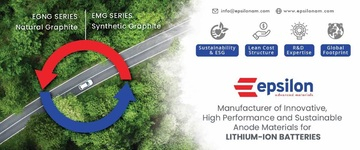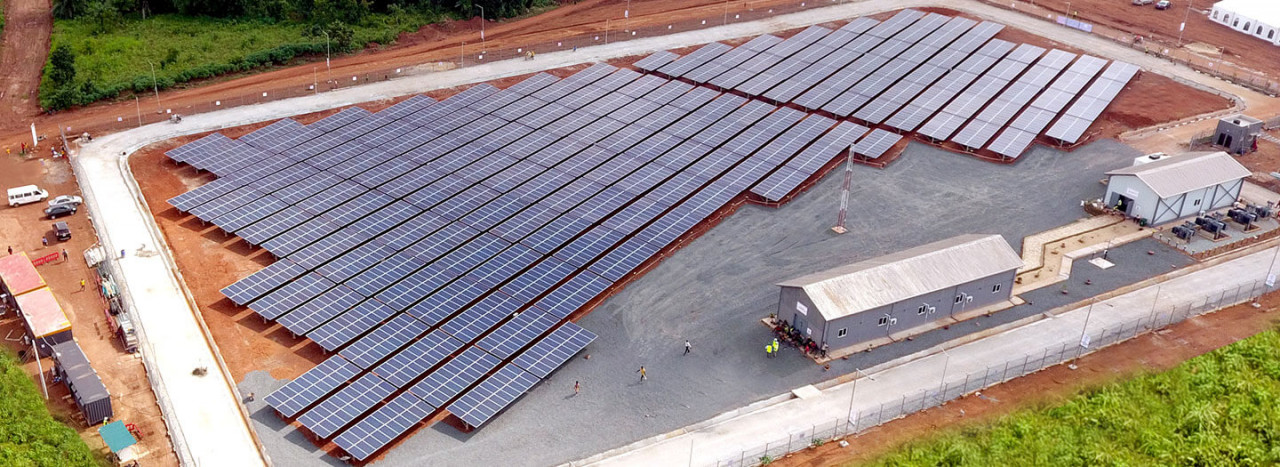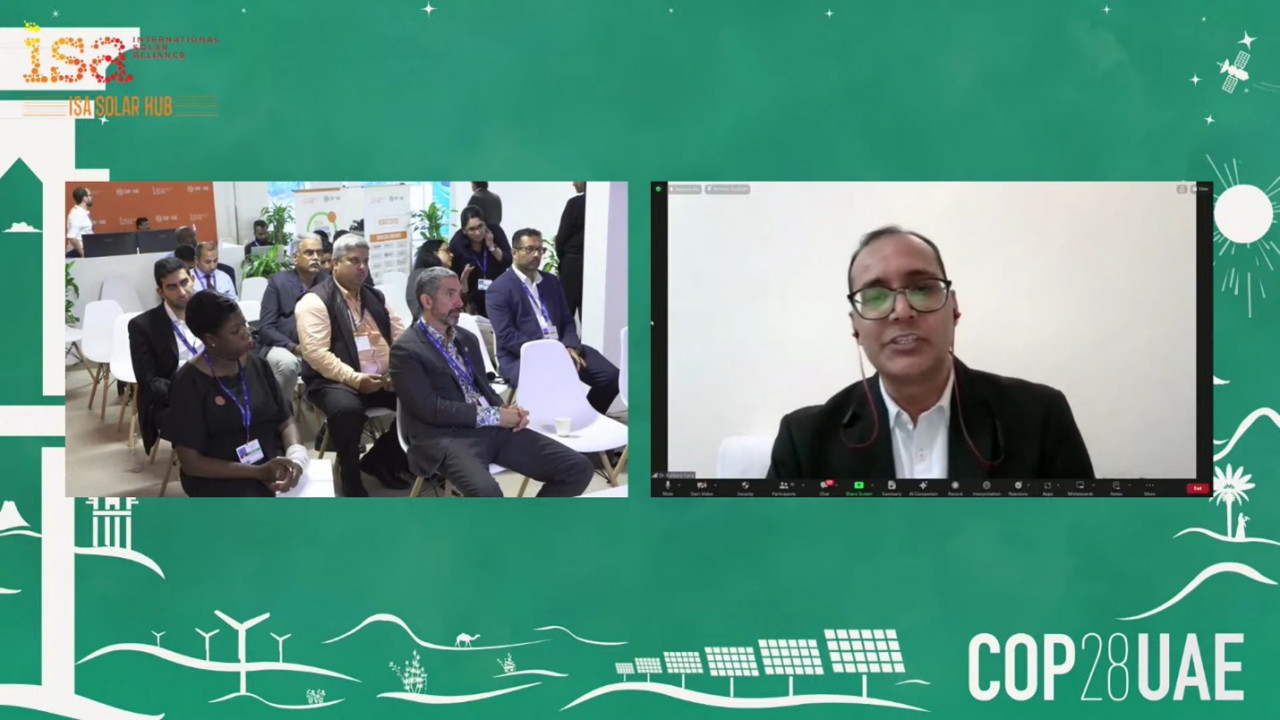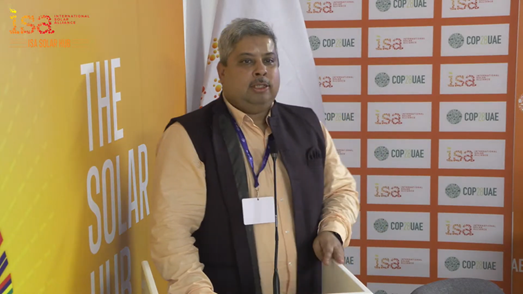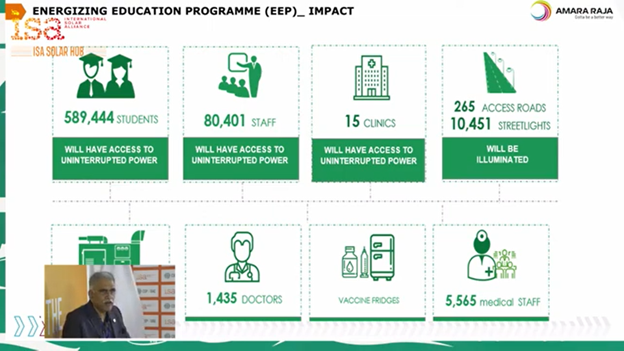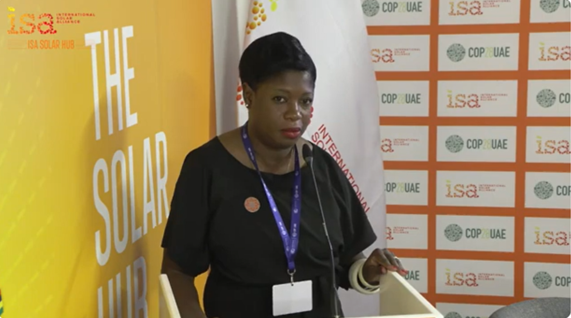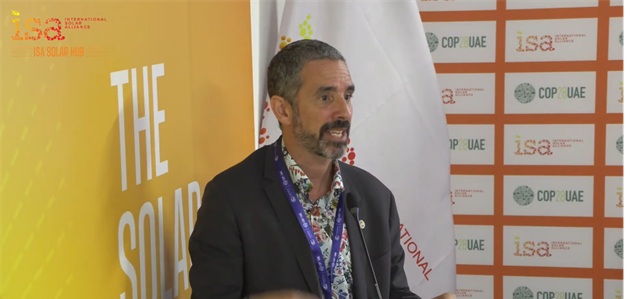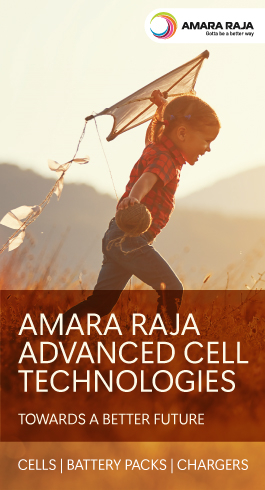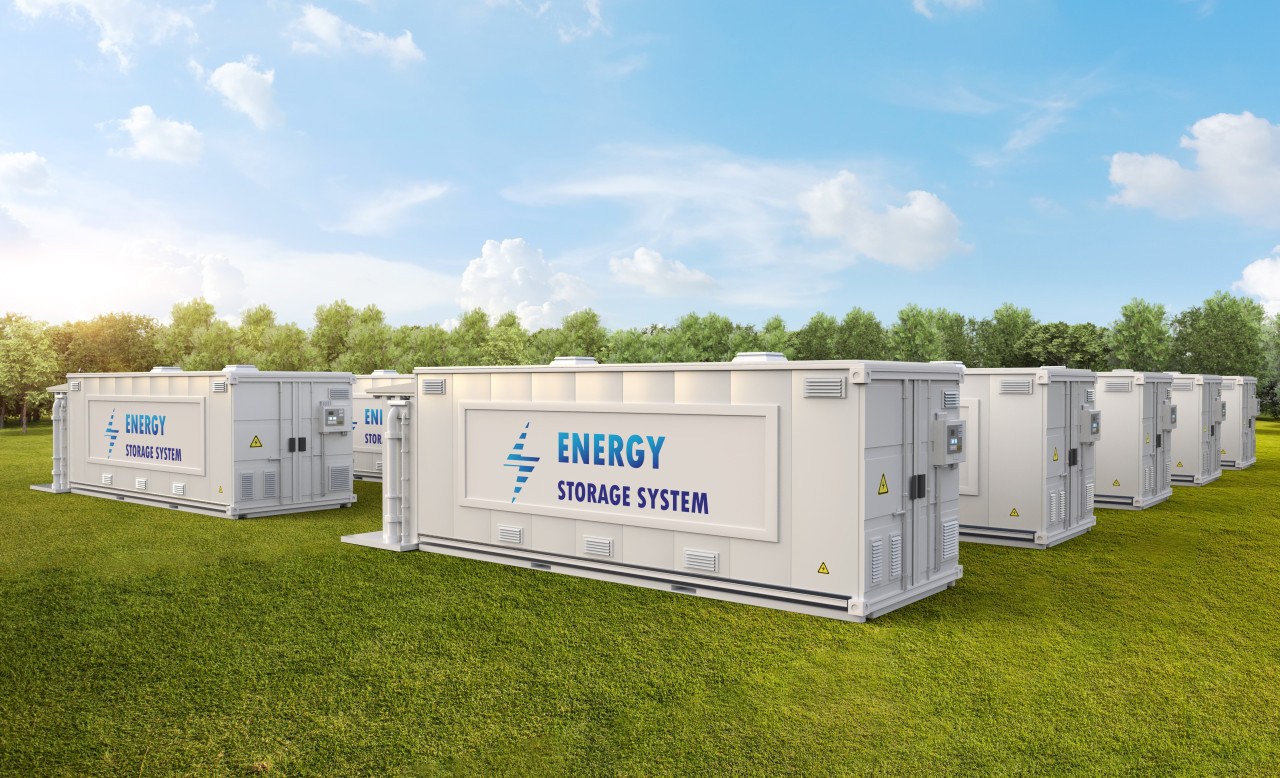COP28: Panel discusses improving energy access in LDC and SIDS through renewables with storage
Global electricity access has risen from 87% in 2015 to 91% in 2021, yet 675 million people, primarily in the least developed countries (LDC) and sub-Saharan Africa lack access to electricity.
If the SDG-7 target, which aims to ensure universal access to affordable, reliable, and modern energy services by 2030 is to be achieved, countries have to increase their efforts on renewable energy, centered on electrification approaches that combine solar with energy storage.
On Day 2 at COP28 in UAE, the International Solar Alliance (ISA) with the Asian Development Bank (ADB) in collaboration with India Energy Storage Alliance (IESA) and National Renewable Energy Laboratory (NREL) held a panel discussion on Universal Energy Access for LDC and SIDS through Solar and BESS: The Storage Perspective. The panelists deliberated on the challenge of energy access in the least developed countries (LDC) and Small Island Developing States (SIDS), shared learnings from projects, and discussed potential solutions.
"To achieve global sustainability, there is a need for strong policies that effectively utilize renewable energy through storage."
Addressing the panel discussion virtually, Dr. Kuldeep Rana, Scientist/Director of Storage, Ministry of New & Renewable Energy (MNRE), Govt. of India highlighted the crucial role of energy storage technologies and the efforts made by the Indian government in encouraging storage deployment. Storage plays a key role in optimizing the utilization of renewable energy, expanding electricity availability in developing nations, and fortifying the resilience of the worldwide energy system. Speaking about the need for strong policies for encouraging storage, Rana said, "To achieve global sustainability, there is a need for strong policies that effectively utilize renewable energy through storage."
He highlighted the efforts of the Government of India to utilize RE through storage. India has committed to achieving net-zero emissions by 2070 and has also set an aggressive clean energy target of achieving 500 GW of installed capacity from non-fossil sources by 2030. Therefore, managing the fluctuation and intermittence in renewable power, especially from the sun and wind, will require extensive storage systems.
Globally, too, there is a huge demand for storage -- for both battery energy storage systems (BESS) as well as pump hydro storage and strong policies will be needed to accelerate the deployment of energy storage projects. Globally, two-thirds of the countries have enacted dedicated policies and regulations for energy storage. However, only half of LDCs and SIDS have implemented such measures.
Currently, the main hurdle to the adoption of storage is cost. To address this, the Indian government has taken several measures such as guidelines for procurement of utilization of the BESS as part of the generation, transmission, and distribution assets along with ancillary services, renewable purchase obligation, and energy storage obligation till 2019-30. We also introduced Battery Waste Management Rule 2022 for safe disposal of batteries and the guidelines for the tariff-based bidding process for setting up 500 MW/1000 MWh BESS pilot project aimed at reducing the levelized cost of energy.
More recently, the Indian government approved Viability Gap Funding for 4000 GWh of BESS. It also launched a Production Linked Incentive (PLI) scheme for the manufacturing of advanced chemistry cell batteries up to 50 GWh capacity annually.
A few recommendations by Rana include planning the need to assess the electricity demand and the potential disruption to power grid which can help in identifying the type of capacity and the location for the required energy storage. Second, focusing and investing in the R&D for the development of new technologies for battery-based energy storage systems to reduce the localized cost of storage. To achieve this India needs a separate PLI catering to the requirements of large-scale and long-duration technologies grid requirements. Skill development and expertise in this field are important to implement such technologies indigenously. And thirdly, in terms of finance, coming up with an innovative business model with support from multi-lateral banks and other global institutions can reduce the barrier of the high cost of the battery. Import duty waiver, and incentives for raw materials and machinery can be extended.
Dr. Rahul Walawalkar - President and MD of Customized Energy Solutions, India. Founder, India Energy Storage Alliance (IESA)
"We have to look at how we can benefit from the advances happening in the distributed generation, especially with solar and wind, and how combining that with energy storage technologies, not necessarily batteries, but even other forms of technologies or even other distributed generation technologies like pump hydro, we could enable access to energy, which can be transformational for millions of people."
Dr. Walawalkar opened his remarks by discussing the two prevalent views that exist on enhancing universal access to energy. One is that mini-grids are essential for last-mile connectivity, especially for the last billion or slightly less than a billion people who still do not have access to energy. The other view is that the best and most economical way to improve access to energy is through grid expansion.
"In my personal view, no one answer is going to fit every country and every region," said Dr. Walawalkar. "We need an economic balance in terms of how much is the load, what is the load profile, how much is the distance required for transporting that power, this will determine if a centralized approach or a decentralized approach is going to work."
However, while the power sector waits for large-scale grid expansion, Dr. Walawalkar reminiscing the words of prominent Indian scientist Homi J. Bhabha cautioned that, "No power is costlier than no power."
He underscored that instead of waiting for decades for large-scale grid expansion and losing generations without access to power --assessing how we can benefit from the advances in technologies around us. "We have to look at how we can benefit from the advances happening in the distributed generation, especially with solar, with wind, and how combining that with energy storage technologies not necessarily batteries but even other forms of technologies or even other distributed generation technologies like pump hydro, we could enable access to energy, which can be transformational for millions of people," Dr. Walawalkar said.
Speaking of the pilot projects and deployments that have happened, he urged the need to share the learnings from these pilots with institutions that would be interested in funding and scaling up mini-grids, microgrids and other electrification approaches that combine renewables with storage.
"Technology progress has made it now possible that we can look at both micro-grids, grid-enabled mini-grids, and where there are economies of scale may be grid expansion, as all three options together so that by 2030 we can make a difference for the millions of people who are looking for these solutions."
Vijayanand Samudrala, President, New Energy at Amara Raja Batteries Limited, India
"It is up to us, the government, and corporate houses like us, to improve these [battery] solutions further, making them safe, improving their life, and making them affordable for all."
Demonstrating how energy can be made accessible to communities that otherwise are not part of the ecosystem, Samudrala presented the learnings from the Amara Raja Batteries solar-plus-battery pilot in Nigeria which has a significant impact on the local community.
The project, solarization of education institutions and the associated needs of society around, owned by the Rural Electrification Agency of the Nigerian government, funded by the Asian Development Bank (ADB) and World Bank with Sterling and Wilson as the EPC contractor and Amara Raja as the energy storage provider – the installation was carried out about four and half years back in 2019. Samudrala pointed the project is set to benefit close to 600,000 students, hundreds of primary health care clinics and medical staff, enable power supply for streetlighting, and refrigerators for storing vaccinations.
The project involved installing a large-scale solar power plant and energy storage system combined to provide round-the-clock power. There are three sites and connected solar power is about 3.5 MWp in one of the sites, which has 24 MWh of energy storage. Amara Raja used advanced lead-acid batteries for this function. The site two has 1.3 MWp of solar with about 8.4 MWh storage and the third site is 0.5MWp with 5.4 MWh of storage. Overall, the project has combined ~38 MWh of lead-acid battery installations to date and had a significant impact in improving access to power in the rural community in Nigeria.
Bringing in an Indian perspective, Samudrala underscored, "Home energy storage has a bigger role to play in India." Samudrala highlighted how home energy storage solutions were the greatest source of storage deployed in India ahead of automotive and industrial use.
It is up to us, the government and corporate houses like us, who need to see how to improve these solutions further, and make them safe, improve their life, and make them affordable for all, Samudrala concluded.
Mukabanji Mutanuka, Head of Business Development - Southern Africa, ENGIE Energy Access
"We have to take a nuanced approach to electrification and there is a need for us to look at it from a sustainability perspective so that our responding to short-term electrification needs does not compromise the sustainability of the future."
Mutanuka highlighted ENGIE's work in South Africa toward enhancing energy access and shared learnings from a project implemented in Zambia.
Noting that most African countries have an average of 12 hours of sunlight, in the remianing12 hours there is a need for technology that can contain that power at one point and dispatch it at the time that it is needed. And that's where battery storage comes in. Mutanuka added that 6-7 years back, lead-acid batteries and gel batteries were dominant because there was enough information and the cost efficiencies were there. However, going further lithium batteries are going to be important, Mutanuka explained.
Mutanuka shared the learnings from ENGIE's 28.35 kilowatts, 96-kilowatt hours or battery storage mini-grid in Chitandika, East of Zambia. The project led ENGIE to explore strategic partnerships to better calibrate the technology for on-field use. "Now we have come to a point, where we can have machines that are providing a service, not just for the community but for the surrounding villages what that does is that it then brings in revenue into that rural economy and that rural economy grows," Mutanuka added.
Mutanuka advocated for having a nuanced approach to electrification in a particular country or region so that responding to short-term electrification needs does not compromise the sustainability of the future.
Stephen Fernands, President, Customized Energy Solutions
"As we get power to last 800 million people on the planet, I think that hybrid model is going to be essential in getting us there."
Stephen Fernands deliberated on how access to electricity in India has expanded in the past decade and more however the benefits of electrification have been unevenly matched.
Sharing insights from a CES study on microgrids, Fernands noted the number one thing that wasn't working for micro-grids was the battery side. Soon after the experts worked on sulfurization issues associated with lead acid batteries, which are still the dominant battery technology. Additionally, some supply chain and maintenance challenges needed to be addressed in that ecosystem as well.
Sharing CES experience of installing a micro-grid in Jharkhand, Stephen explained, that there was no electricity in some of these communities so for a micro-grid to be self-sustainable there had to be a productive anchor tenant. And CES was able to do so by putting in a farm equipment processing unit. This not only increased the overall utilization of that electric current but also resulted in increasing the wealth of that village where villagers were able to pay for not only electricity but also medical and other life needs.
Addressing the question of whether access to energy is going to be grid-connected or through a decentralized approach, Fernands likened it to the early days of computers where everyone believed it would be centralized but with the coming of personal computers, it became extremely decentralized.
"I believe, we will have a much more hybrid model. And as we get power to last 800 million people on the planet, I think that hybrid model is going to be essential in getting us there," he concluded.
The panel concluded with a note that universal access to electricity is possible through a combination of pathways such as grid expansion, mini-grids, and solar plus storage, depending on the local characteristics of energy demand.


